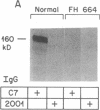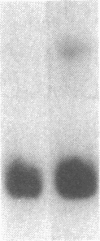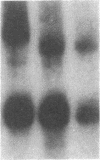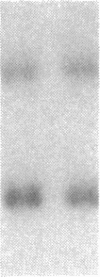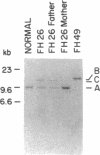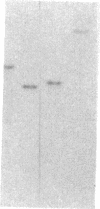Abstract
The low density lipoprotein (LDL) receptors in fibroblasts from 132 subjects with the clinical syndrome of homozygous familial hypercholesterolemia were analyzed by immunoprecipitation with an anti-LDL receptor monoclonal antibody. 16 of the 132 cell strains (12%) synthesized no immunodetectable LDL receptor protein, indicating the presence of two mutant genes that failed to produce cross-reacting material (crm- mutations). DNA and mRNA from 15 of the 16 crm- patients, representing 30 crm- genes, were available for further study. Haplotype analysis based on 10 restriction fragment length polymorphisms (RFLPs) suggested that the 30 crm- genes represent 13 mutant alleles. Four of the alleles produced no mRNA. Three of these four mRNA- alleles had large deletions ranging from 6 to 20 kb that eliminated the promoter region of the gene. The fourth mRNA- allele did not contain any deletion or alteration in the promoter sequence; the reason for the mRNA- phenotype was not apparent. Nine alleles were positive for mRNAs, of which three encoded mRNAs of abnormal size. One of the abnormal mRNAs was produced by a gene harboring a deletion, and another was produced by a gene with a complex rearrangement. The third abnormal-sized mRNA (3.1 kb larger than normal) was produced by an allele that had no detectable alterations as judged by Southern blotting. The other six mRNA+ alleles appeared normal by Southern blotting and produced normal-sized mRNA but no receptor protein. The current studies demonstrate that mRNA analysis coupled with haplotype determination by Southern blot analysis can be used to classify crm- mutations at a genetic locus where multiple alleles exist.
Full text
PDF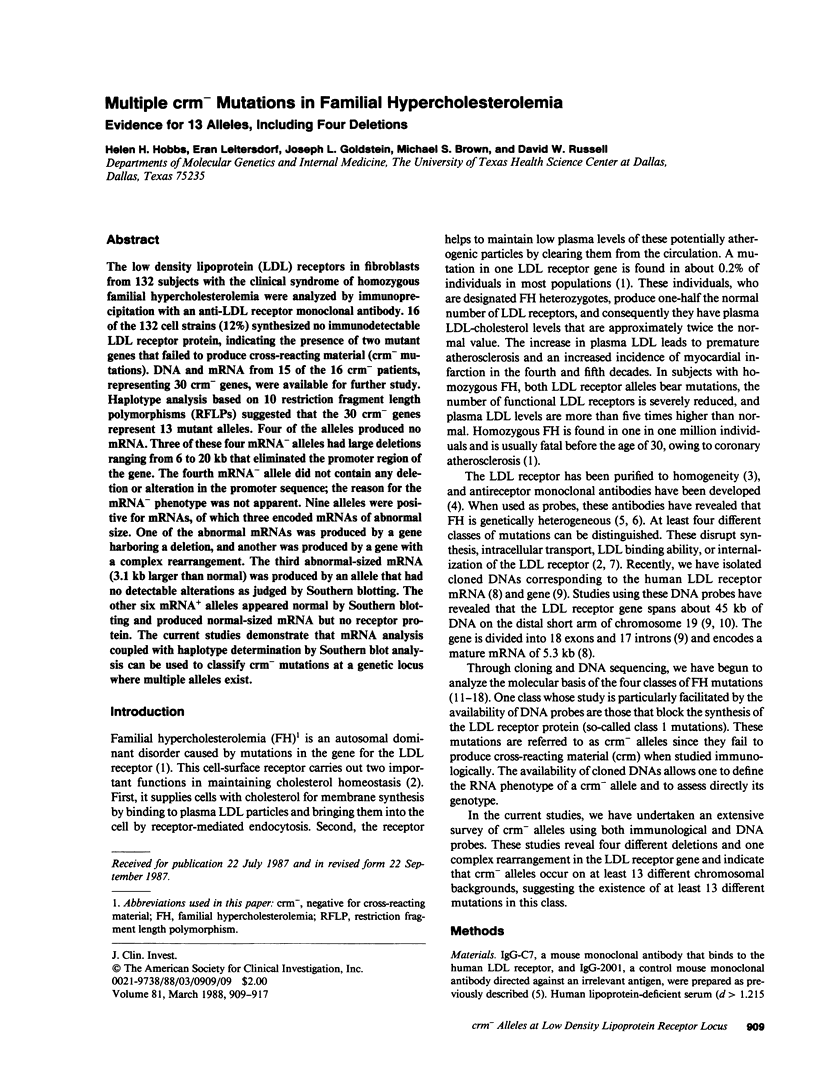
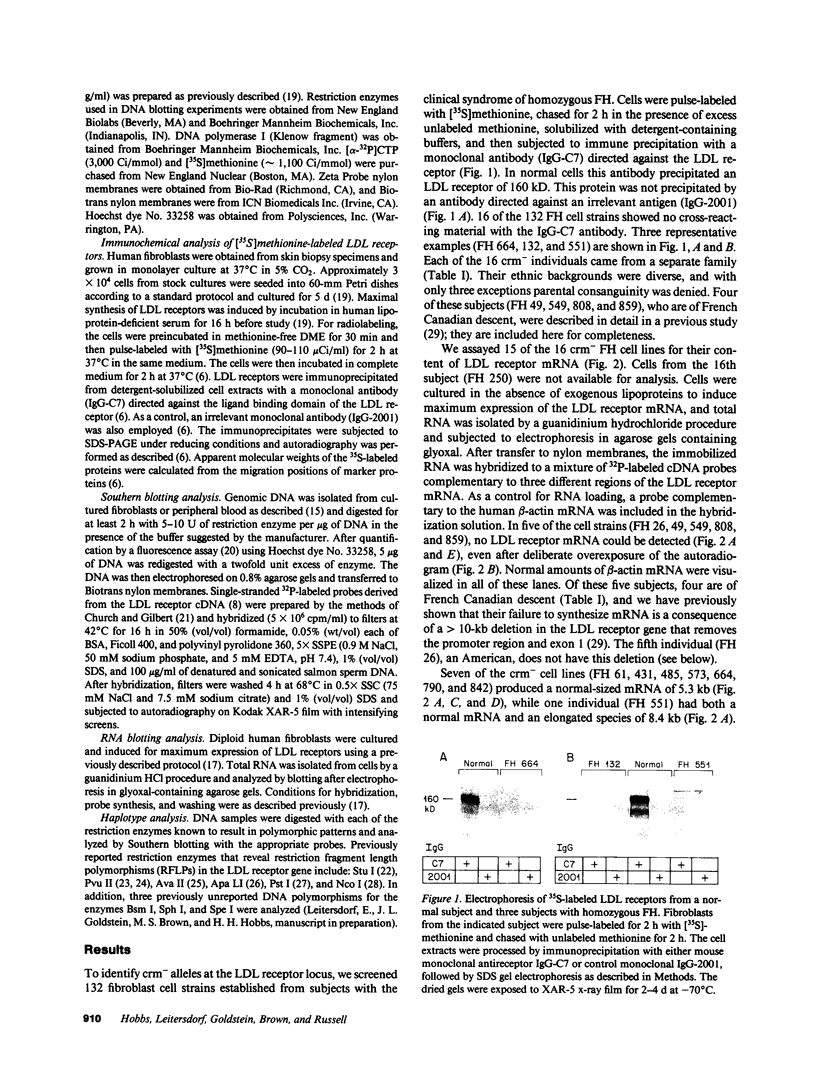
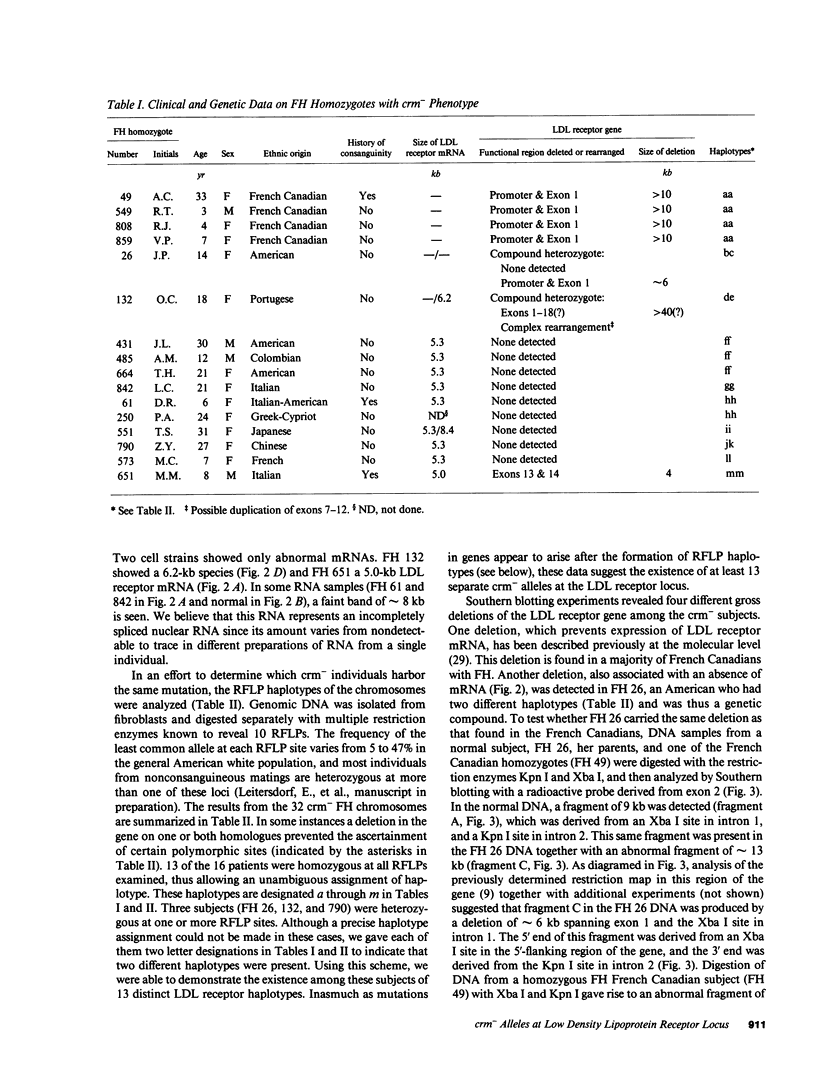
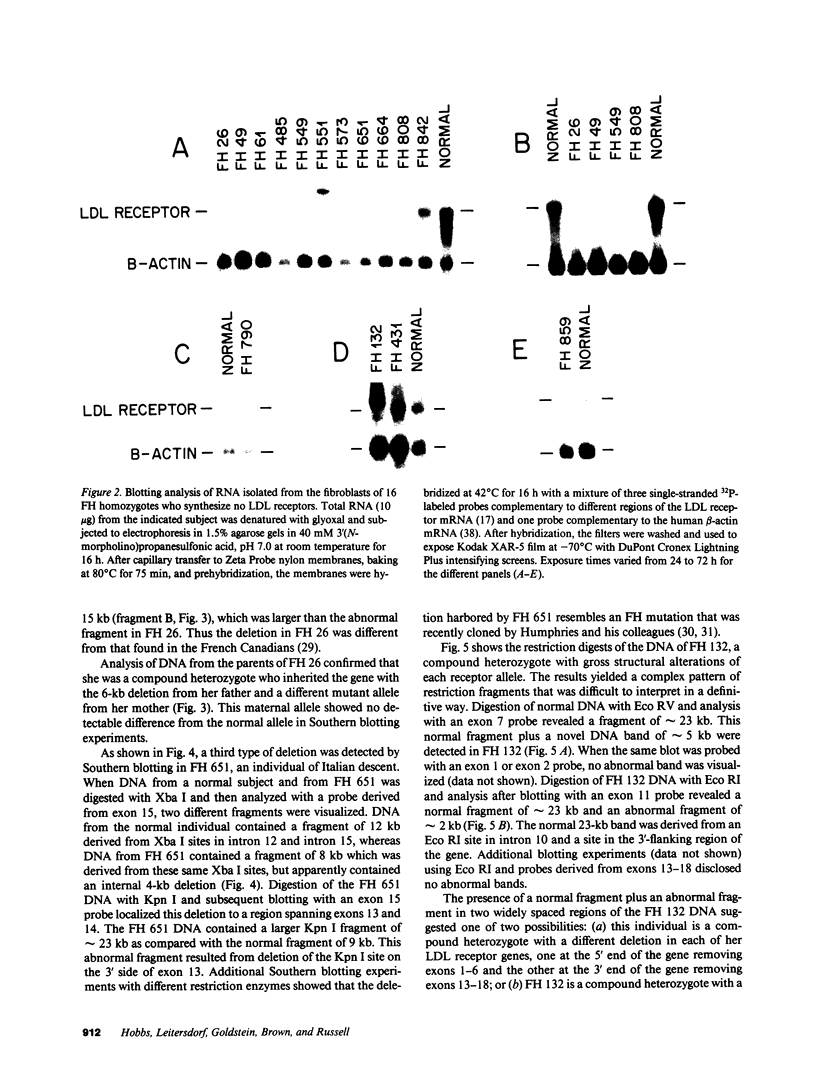
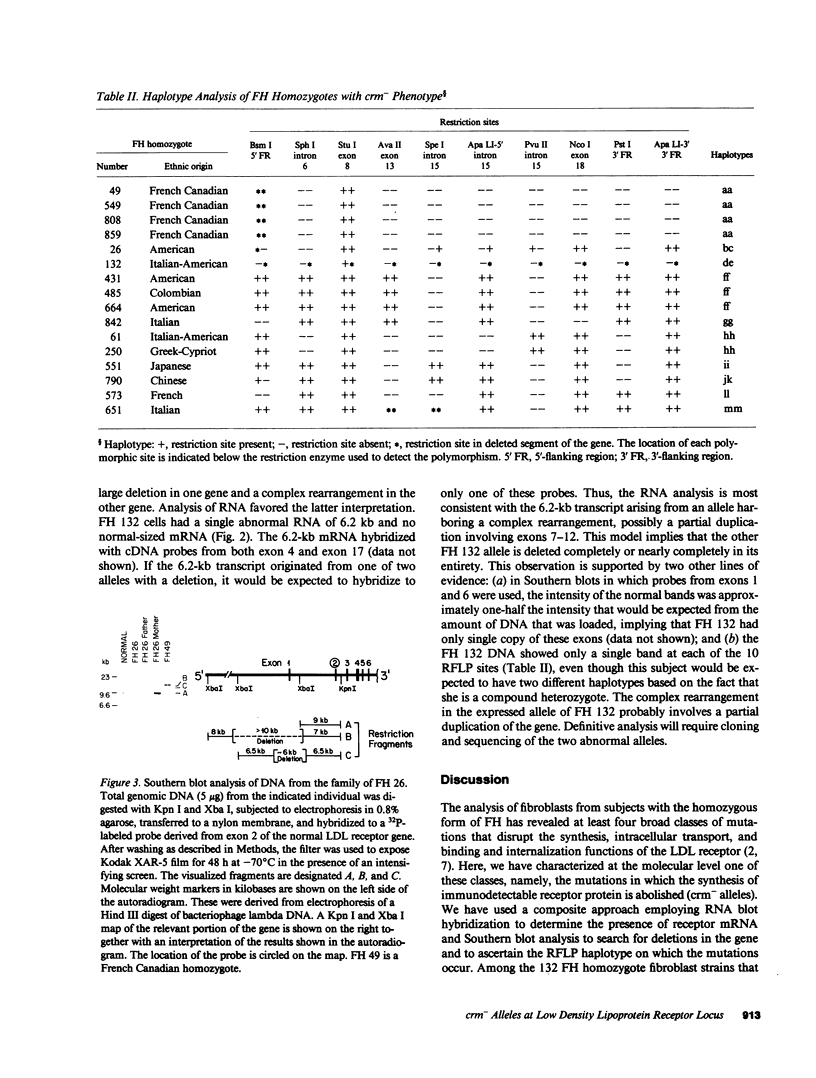
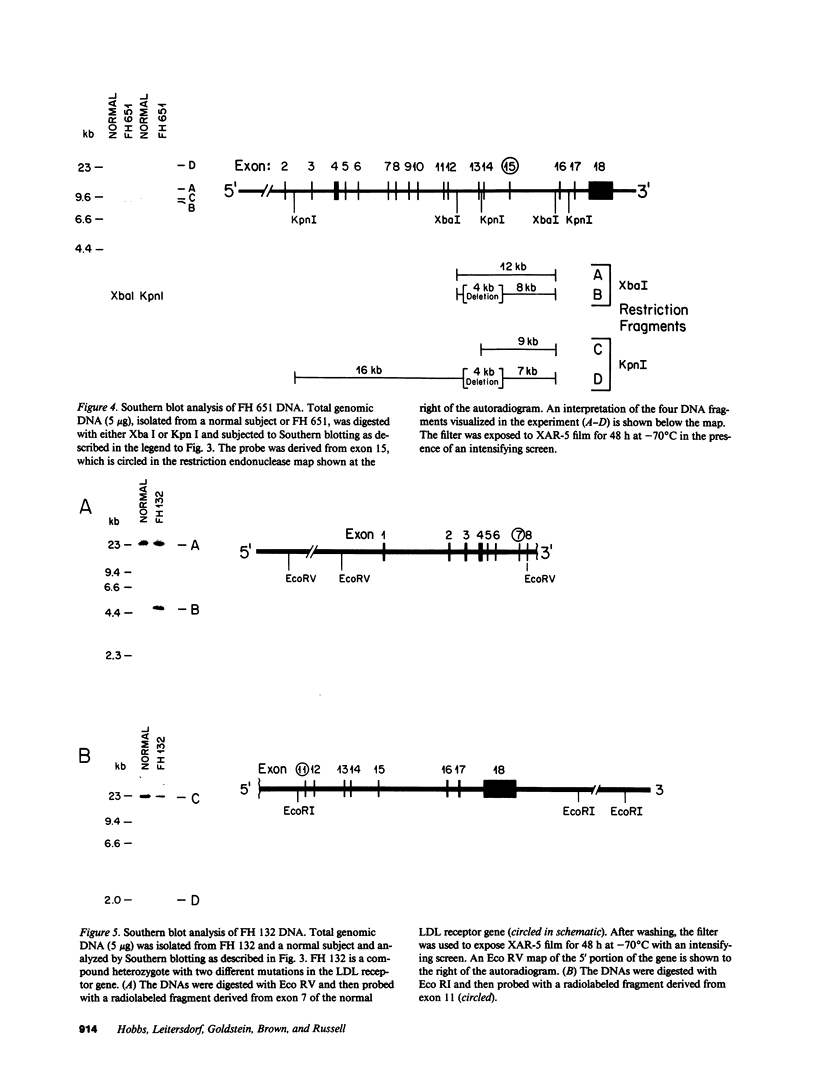
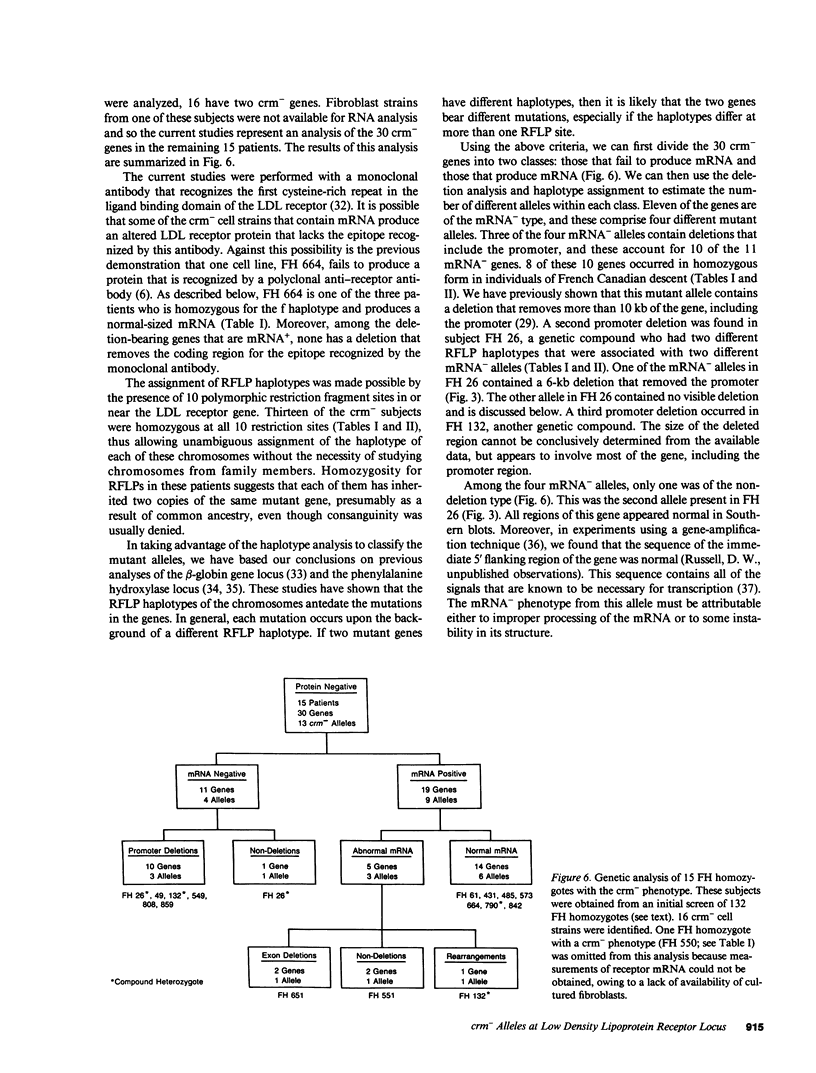
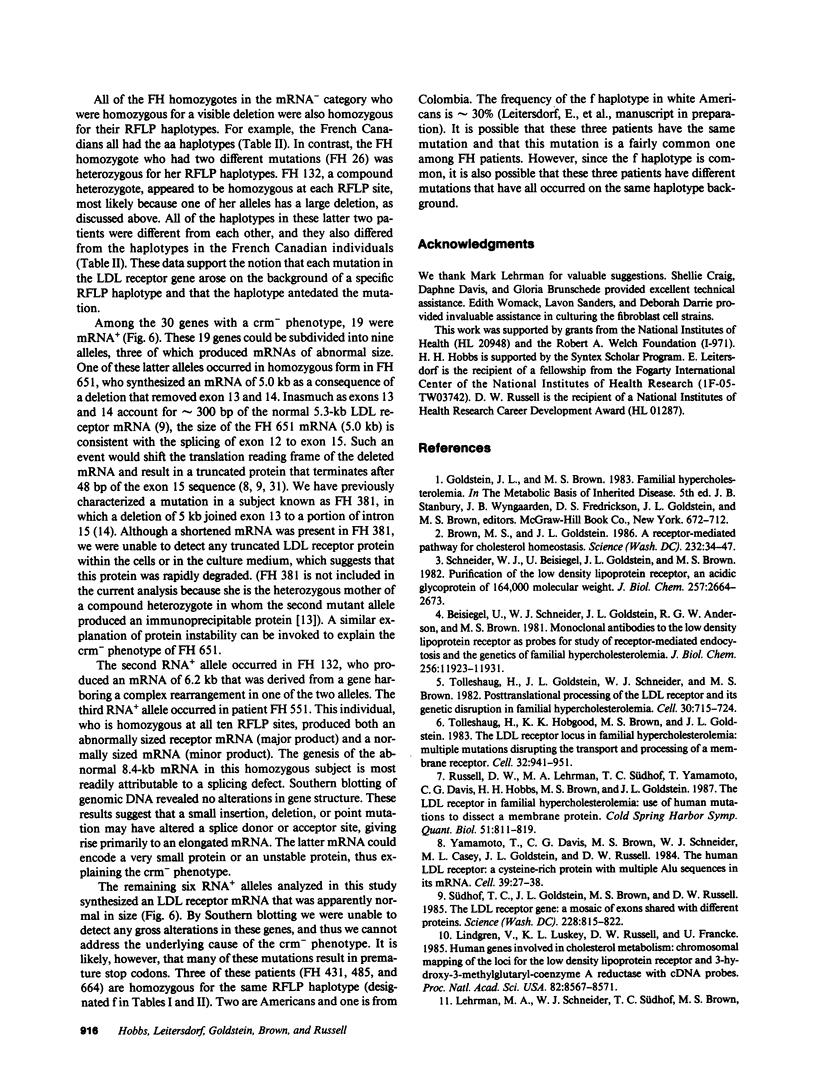
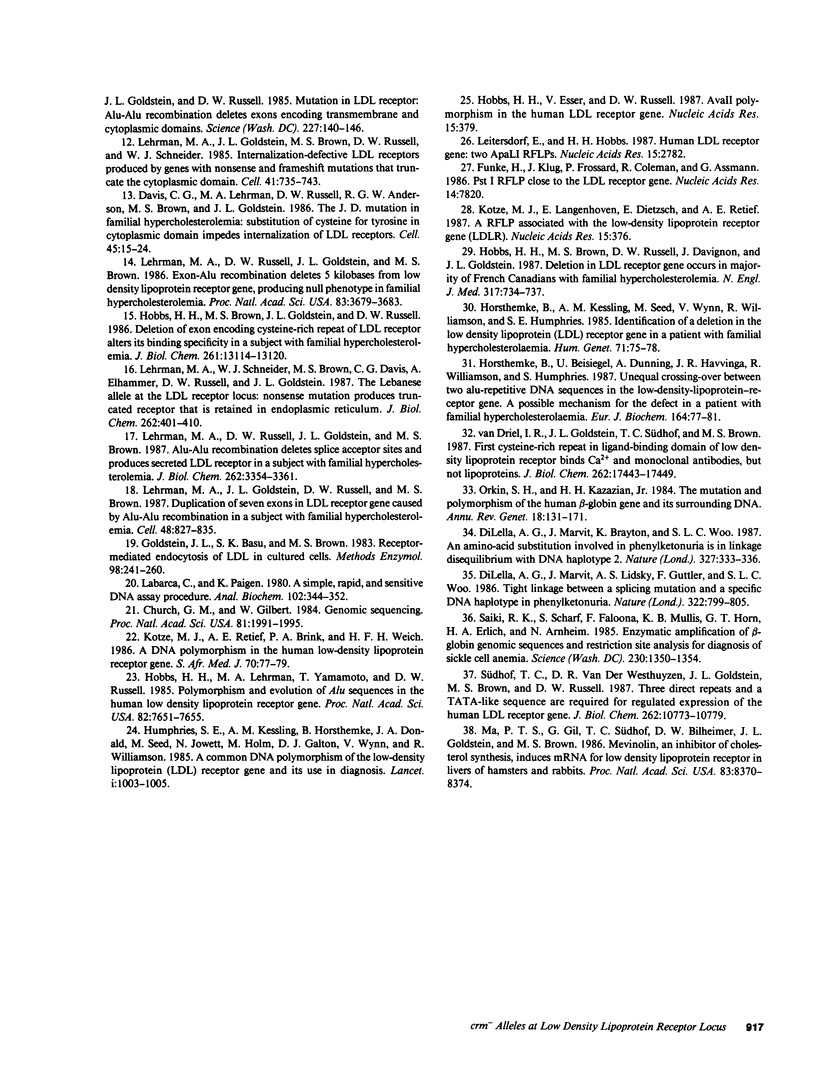
Images in this article
Selected References
These references are in PubMed. This may not be the complete list of references from this article.
- Beisiegel U., Schneider W. J., Goldstein J. L., Anderson R. G., Brown M. S. Monoclonal antibodies to the low density lipoprotein receptor as probes for study of receptor-mediated endocytosis and the genetics of familial hypercholesterolemia. J Biol Chem. 1981 Nov 25;256(22):11923–11931. [PubMed] [Google Scholar]
- Brown M. S., Goldstein J. L. A receptor-mediated pathway for cholesterol homeostasis. Science. 1986 Apr 4;232(4746):34–47. doi: 10.1126/science.3513311. [DOI] [PubMed] [Google Scholar]
- Church G. M., Gilbert W. Genomic sequencing. Proc Natl Acad Sci U S A. 1984 Apr;81(7):1991–1995. doi: 10.1073/pnas.81.7.1991. [DOI] [PMC free article] [PubMed] [Google Scholar]
- Davis C. G., Lehrman M. A., Russell D. W., Anderson R. G., Brown M. S., Goldstein J. L. The J.D. mutation in familial hypercholesterolemia: amino acid substitution in cytoplasmic domain impedes internalization of LDL receptors. Cell. 1986 Apr 11;45(1):15–24. doi: 10.1016/0092-8674(86)90533-7. [DOI] [PubMed] [Google Scholar]
- DiLella A. G., Marvit J., Brayton K., Woo S. L. An amino-acid substitution involved in phenylketonuria is in linkage disequilibrium with DNA haplotype 2. 1987 May 28-Jun 3Nature. 327(6120):333–336. doi: 10.1038/327333a0. [DOI] [PubMed] [Google Scholar]
- DiLella A. G., Marvit J., Lidsky A. S., Güttler F., Woo S. L. Tight linkage between a splicing mutation and a specific DNA haplotype in phenylketonuria. 1986 Aug 28-Sep 3Nature. 322(6082):799–803. doi: 10.1038/322799a0. [DOI] [PubMed] [Google Scholar]
- Funke H., Klug J., Frossard P., Coleman R., Assmann G. Pst I RFLP close to the LDL receptor gene. Nucleic Acids Res. 1986 Oct 10;14(19):7820–7820. doi: 10.1093/nar/14.19.7820. [DOI] [PMC free article] [PubMed] [Google Scholar]
- Goldstein J. L., Basu S. K., Brown M. S. Receptor-mediated endocytosis of low-density lipoprotein in cultured cells. Methods Enzymol. 1983;98:241–260. doi: 10.1016/0076-6879(83)98152-1. [DOI] [PubMed] [Google Scholar]
- Hobbs H. H., Brown M. S., Goldstein J. L., Russell D. W. Deletion of exon encoding cysteine-rich repeat of low density lipoprotein receptor alters its binding specificity in a subject with familial hypercholesterolemia. J Biol Chem. 1986 Oct 5;261(28):13114–13120. [PubMed] [Google Scholar]
- Hobbs H. H., Brown M. S., Russell D. W., Davignon J., Goldstein J. L. Deletion in the gene for the low-density-lipoprotein receptor in a majority of French Canadians with familial hypercholesterolemia. N Engl J Med. 1987 Sep 17;317(12):734–737. doi: 10.1056/NEJM198709173171204. [DOI] [PubMed] [Google Scholar]
- Hobbs H. H., Esser V., Russell D. W. AvaII polymorphism in the human LDL receptor gene. Nucleic Acids Res. 1987 Jan 12;15(1):379–379. doi: 10.1093/nar/15.1.379. [DOI] [PMC free article] [PubMed] [Google Scholar]
- Hobbs H. H., Lehrman M. A., Yamamoto T., Russell D. W. Polymorphism and evolution of Alu sequences in the human low density lipoprotein receptor gene. Proc Natl Acad Sci U S A. 1985 Nov;82(22):7651–7655. doi: 10.1073/pnas.82.22.7651. [DOI] [PMC free article] [PubMed] [Google Scholar]
- Horsthemke B., Beisiegel U., Dunning A., Havinga J. R., Williamson R., Humphries S. Unequal crossing-over between two alu-repetitive DNA sequences in the low-density-lipoprotein-receptor gene. A possible mechanism for the defect in a patient with familial hypercholesterolaemia. Eur J Biochem. 1987 Apr 1;164(1):77–81. doi: 10.1111/j.1432-1033.1987.tb10995.x. [DOI] [PubMed] [Google Scholar]
- Horsthemke B., Kessling A. M., Seed M., Wynn V., Williamson R., Humphries S. E. Identification of a deletion in the low density lipoprotein (LDL) receptor gene in a patient with familial hypercholesterolaemia. Hum Genet. 1985;71(1):75–78. doi: 10.1007/BF00295672. [DOI] [PubMed] [Google Scholar]
- Humphries S. E., Kessling A. M., Horsthemke B., Donald J. A., Seed M., Jowett N., Holm M., Galton D. J., Wynn V., Williamson R. A common DNA polymorphism of the low-density lipoprotein (LDL) receptor gene and its use in diagnosis. Lancet. 1985 May 4;1(8436):1003–1005. doi: 10.1016/s0140-6736(85)91611-3. [DOI] [PubMed] [Google Scholar]
- Kotze M. J., Langenhoven E., Dietzsch E., Retief A. E. A RFLP associated with the low-density lipoprotein receptor gene (LDLR). Nucleic Acids Res. 1987 Jan 12;15(1):376–376. doi: 10.1093/nar/15.1.376. [DOI] [PMC free article] [PubMed] [Google Scholar]
- Kotze M. J., Retief A. E., Brink P. A., Weich H. F. A DNA polymorphism in the human low-density lipoprotein receptor gene. S Afr Med J. 1986 Jul 19;70(2):77–79. [PubMed] [Google Scholar]
- Labarca C., Paigen K. A simple, rapid, and sensitive DNA assay procedure. Anal Biochem. 1980 Mar 1;102(2):344–352. doi: 10.1016/0003-2697(80)90165-7. [DOI] [PubMed] [Google Scholar]
- Lehrman M. A., Goldstein J. L., Brown M. S., Russell D. W., Schneider W. J. Internalization-defective LDL receptors produced by genes with nonsense and frameshift mutations that truncate the cytoplasmic domain. Cell. 1985 Jul;41(3):735–743. doi: 10.1016/s0092-8674(85)80054-4. [DOI] [PubMed] [Google Scholar]
- Lehrman M. A., Goldstein J. L., Russell D. W., Brown M. S. Duplication of seven exons in LDL receptor gene caused by Alu-Alu recombination in a subject with familial hypercholesterolemia. Cell. 1987 Mar 13;48(5):827–835. doi: 10.1016/0092-8674(87)90079-1. [DOI] [PubMed] [Google Scholar]
- Lehrman M. A., Russell D. W., Goldstein J. L., Brown M. S. Alu-Alu recombination deletes splice acceptor sites and produces secreted low density lipoprotein receptor in a subject with familial hypercholesterolemia. J Biol Chem. 1987 Mar 5;262(7):3354–3361. [PubMed] [Google Scholar]
- Lehrman M. A., Russell D. W., Goldstein J. L., Brown M. S. Exon-Alu recombination deletes 5 kilobases from the low density lipoprotein receptor gene, producing a null phenotype in familial hypercholesterolemia. Proc Natl Acad Sci U S A. 1986 Jun;83(11):3679–3683. doi: 10.1073/pnas.83.11.3679. [DOI] [PMC free article] [PubMed] [Google Scholar]
- Lehrman M. A., Schneider W. J., Brown M. S., Davis C. G., Elhammer A., Russell D. W., Goldstein J. L. The Lebanese allele at the low density lipoprotein receptor locus. Nonsense mutation produces truncated receptor that is retained in endoplasmic reticulum. J Biol Chem. 1987 Jan 5;262(1):401–410. [PubMed] [Google Scholar]
- Lehrman M. A., Schneider W. J., Südhof T. C., Brown M. S., Goldstein J. L., Russell D. W. Mutation in LDL receptor: Alu-Alu recombination deletes exons encoding transmembrane and cytoplasmic domains. Science. 1985 Jan 11;227(4683):140–146. doi: 10.1126/science.3155573. [DOI] [PMC free article] [PubMed] [Google Scholar]
- Leitersdorf E., Hobbs H. H. Human LDL receptor gene: two ApaLI RFLPs. Nucleic Acids Res. 1987 Mar 25;15(6):2782–2782. doi: 10.1093/nar/15.6.2782. [DOI] [PMC free article] [PubMed] [Google Scholar]
- Lindgren V., Luskey K. L., Russell D. W., Francke U. Human genes involved in cholesterol metabolism: chromosomal mapping of the loci for the low density lipoprotein receptor and 3-hydroxy-3-methylglutaryl-coenzyme A reductase with cDNA probes. Proc Natl Acad Sci U S A. 1985 Dec;82(24):8567–8571. doi: 10.1073/pnas.82.24.8567. [DOI] [PMC free article] [PubMed] [Google Scholar]
- Ma P. T., Gil G., Südhof T. C., Bilheimer D. W., Goldstein J. L., Brown M. S. Mevinolin, an inhibitor of cholesterol synthesis, induces mRNA for low density lipoprotein receptor in livers of hamsters and rabbits. Proc Natl Acad Sci U S A. 1986 Nov;83(21):8370–8374. doi: 10.1073/pnas.83.21.8370. [DOI] [PMC free article] [PubMed] [Google Scholar]
- Orkin S. H., Kazazian H. H., Jr The mutation and polymorphism of the human beta-globin gene and its surrounding DNA. Annu Rev Genet. 1984;18:131–171. doi: 10.1146/annurev.ge.18.120184.001023. [DOI] [PubMed] [Google Scholar]
- Russell D. W., Lehrman M. A., Südhof T. C., Yamamoto T., Davis C. G., Hobbs H. H., Brown M. S., Goldstein J. L. The LDL receptor in familial hypercholesterolemia: use of human mutations to dissect a membrane protein. Cold Spring Harb Symp Quant Biol. 1986;51(Pt 2):811–819. doi: 10.1101/sqb.1986.051.01.094. [DOI] [PubMed] [Google Scholar]
- Saiki R. K., Scharf S., Faloona F., Mullis K. B., Horn G. T., Erlich H. A., Arnheim N. Enzymatic amplification of beta-globin genomic sequences and restriction site analysis for diagnosis of sickle cell anemia. Science. 1985 Dec 20;230(4732):1350–1354. doi: 10.1126/science.2999980. [DOI] [PubMed] [Google Scholar]
- Schneider W. J., Beisiegel U., Goldstein J. L., Brown M. S. Purification of the low density lipoprotein receptor, an acidic glycoprotein of 164,000 molecular weight. J Biol Chem. 1982 Mar 10;257(5):2664–2673. [PubMed] [Google Scholar]
- Südhof T. C., Goldstein J. L., Brown M. S., Russell D. W. The LDL receptor gene: a mosaic of exons shared with different proteins. Science. 1985 May 17;228(4701):815–822. doi: 10.1126/science.2988123. [DOI] [PMC free article] [PubMed] [Google Scholar]
- Südhof T. C., Van der Westhuyzen D. R., Goldstein J. L., Brown M. S., Russell D. W. Three direct repeats and a TATA-like sequence are required for regulated expression of the human low density lipoprotein receptor gene. J Biol Chem. 1987 Aug 5;262(22):10773–10779. [PubMed] [Google Scholar]
- Tolleshaug H., Goldstein J. L., Schneider W. J., Brown M. S. Posttranslational processing of the LDL receptor and its genetic disruption in familial hypercholesterolemia. Cell. 1982 Oct;30(3):715–724. doi: 10.1016/0092-8674(82)90276-8. [DOI] [PubMed] [Google Scholar]
- Tolleshaug H., Hobgood K. K., Brown M. S., Goldstein J. L. The LDL receptor locus in familial hypercholesterolemia: multiple mutations disrupt transport and processing of a membrane receptor. Cell. 1983 Mar;32(3):941–951. doi: 10.1016/0092-8674(83)90079-x. [DOI] [PubMed] [Google Scholar]
- Yamamoto T., Davis C. G., Brown M. S., Schneider W. J., Casey M. L., Goldstein J. L., Russell D. W. The human LDL receptor: a cysteine-rich protein with multiple Alu sequences in its mRNA. Cell. 1984 Nov;39(1):27–38. doi: 10.1016/0092-8674(84)90188-0. [DOI] [PubMed] [Google Scholar]
- van Driel I. R., Goldstein J. L., Südhof T. C., Brown M. S. First cysteine-rich repeat in ligand-binding domain of low density lipoprotein receptor binds Ca2+ and monoclonal antibodies, but not lipoproteins. J Biol Chem. 1987 Dec 25;262(36):17443–17449. [PubMed] [Google Scholar]



